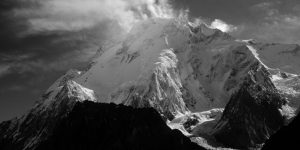What Happened On June 9th?
Nestled in the heart of the Karakoram Range, Broad Peak soars to an altitude of 8,051 meters. On June 9th of 1957, this colossal mountain was finally conquered by a team of determined four Austrian climbers.
The Climb Begins
The story of Broad Peak’s first ascent is intertwined with the personalities and skills of four Austrian climbers: Fritz Wintersteller, Marcus Schmuck, Kurt Diemberger, and Hermann Buhl. Each climber brought a unique set of skills and experiences, which contributed to a cohesive and dynamic team. Their journey to the summit of Broad Peak began long before they set foot on the icy slopes, rooted in months of rigorous preparation and training.
In the early stages of the expedition, the climbers faced a few logistical challenges. Transporting their gear through the rugged terrain of the Karakoram Range required both physical stamina and meticulous planning. The team relied on local porters, who, with their intimate knowledge of the region, played an indispensable role in navigating the treacherous landscape. Establishing a base camp at approximately 4,800 meters was their first major task.
Charting The Route
The Austrian team’s strategy for conquering Broad Peak was innovative and somewhat unconventional for the time. They decided to use a lightweight, alpine-style approach, different from the traditional methods that involved setting up multiple camps and relying on fixed ropes. This decision was influenced by their desire for speed and efficiency, minimizing their exposure to the harsh and unpredictable weather conditions of the Karakoram Range.

In the weeks leading up to their final push, the team acclimatized by establishing higher camps and conducting reconnaissance climbs. Their approach was methodical, carefully balancing the need for acclimatization with the imperative of conserving energy. The climbers were acutely aware of the thin margin for error in such extreme conditions, where a miscalculation or lapse in judgment could have catastrophic consequences.
The Summit Push
On the morning of June 8th, the climbers set out from their high camp, situated at approximately 7,000 meters. The air was thin, and each step required immense effort and determination. The team moved steadily through a labyrinth of crevasses and ice walls. As the hours passed, the physical toll of the ascent became increasingly apparent. Despite the challenges, the climbers maintained their focus, driven by a shared resolve to reach the summit.
In the early morning of June 9th, the team found themselves within striking distance of the summit. The final stretch of the climb was the most treacherous, characterized by steep inclines and precarious ice formations. It was at this juncture that the climbers’ collective experience and camaraderie proved invaluable. With each step, they inched closer to their goal, their spirits buoyed by the breathtaking views around them.
A Peak Moment
At approximately 10:30 AM, Fritz Wintersteller, Marcus Schmuck, Kurt Diemberger, and Hermann Buhl stood together on the summit of Broad Peak. The moment was one of profound elation and relief, a culmination of years of dreaming, planning, and relentless effort.
The climbers unfurled the Austrian flag, a symbol of their achievement and a tribute to their homeland. For Hermann Buhl, this triumph meant even more; just two years earlier, he had become the first person to reach the summit of Nanga Parbat, another formidable peak in the Karakoram Range.

The Careful Descent
While reaching the summit was just remarkable, the descent posed its own set of challenges. The team was acutely aware that many mountaineering tragedies occur during the descent, when exhaustion and elation can lead to lapses in concentration. Demonstrating their discipline and focus, the climbers meticulously retraced their steps, navigating the treacherous terrain with caution.
By late afternoon, the team safely returned to their high camp, greeted by the exhilaration of their fellow climbers and support crew.
Broad Peak vs Mt. Everest
Mount Everest, towering at 8,848 meters, is the highest peak on Earth, making it an enduring symbol of human aspiration and achievement. The sheer altitude of Everest introduces climbers to extreme conditions, including the notorious “death zone” above 8,000 meters, where the oxygen levels are insufficient to sustain human life for extended periods.
The severe weather, with its unpredictable storms and bone-chilling temperatures, adds to the challenge. The mountain’s massive size also means longer and more grueling expeditions, often requiring weeks of acclimatization and preparation. That being said, the ascent of Mount Everest in 1953 by Sir Edmund Hillary and Tenzing Norgay was unbelievable.
Broad Peak, while slightly shorter at 8,051 meters, presents its own formidable difficulties. Its location in the Karakoram Range subjects climbers to harsh weather conditions similar to those on Everest, but with added unpredictability. The ascent involves treacherous crevasses, steep ice walls, and exposed ridges.
Unlike Everest’s relatively well-trodden paths, Broad Peak’s routes are less established, demanding superior navigation skills and adaptability. The alpine-style approach often employed here, which focuses on speed and minimal equipment, requires exceptional physical conditioning and mental resilience. Although Broad Peak might lack the height of Everest, the technical challenges and severe environment make it an equally daunting endeavor.





